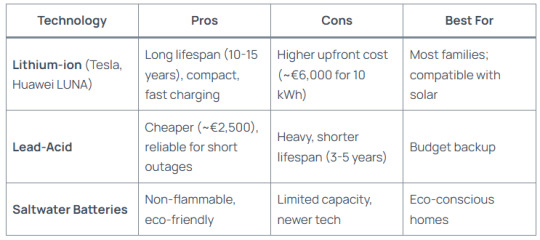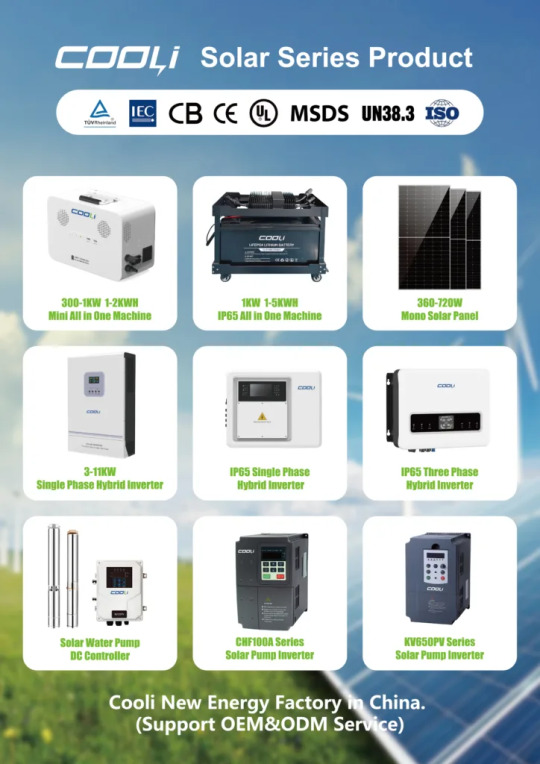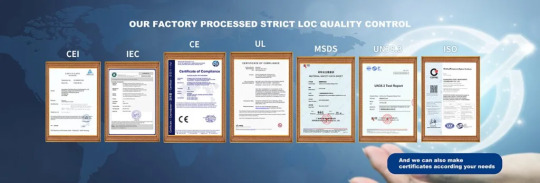https://coolithium.com - Looking for top-tier LiFePO4 batteries and inverters? We provide the highest quality, most cost-effective solutions for residential and industrial energy needs. Engineered by professionals, built for longevity, and backed by excellent support. Power your world with confidence!
Don't wanna be here? Send us removal request.
Text
Spain Blackout Crisis: Home Batteries Saved €800 & Avoided Disaster!
Why Home Batteries Energy Storage is Now Essential for Spanish, Portuguese, and French Households: Lessons from the 2025 Blackout Crisis

On April 28, 2025, a catastrophic power outage plunged Spain, Portugal, and southern France into darkness, leaving millions stranded without electricity for nearly 10 hours. Trains halted, hospitals scrambled, and supermarkets faced chaos as citizens rushed to stockpile essentials. This unprecedented event exposed the fragility of modern energy systems—and made one thing clear: home energy storage is no longer a luxury but a necessity.
Here’s why households across Iberia and Southern Europe must prioritize energy independence now—and how to choose the right solution.
1. The Blackout Wake-Up Call: Why Grids Failed
The 2025 outage was triggered by a sudden loss of 15 GW of power in Spain’s grid within seconds, crippling a system already strained by Europe’s rapid renewable transition. Experts identified three critical flaws:
Overreliance on intermittent renewables: Spain’s grid had just celebrated 100% renewable power days before the blackout. Yet, solar and wind’s variability, paired with inadequate grid storage, left the system vulnerable to sudden demand spikes.
Aging infrastructure: Transmission lines buckled under record temperatures, highlighting outdated networks ill-equipped for climate extremes.
Weak cross-border connections: Limited links between Spain, France, and Portugal turned localized failures into a regional crisis.
For families, this meant no refrigeration for food, disabled medical devices, and zero communication as networks collapsed.
2. Home Batteries: Your Lifeline During Crises
Households with solar panels and storage systems weathered the blackout safely. Here’s how home batteries protect you:
Guarantee Basic Survival Needs
Keep lights, phones, and WiFi running: Critical for emergency alerts and contacting loved ones.
Preserve food and medicine: A 5 kWh battery (e.g., Tesla Powerwall) can power a fridge for 18+ hours.
Support medical devices: Diabetics, oxygen users, and others avoided life-threatening risks.
Slash Energy Bills Year-Round
Spain’s soaring electricity prices (up 40% since 2022) make storage a smart investment even without blackouts:
Store solar energy: Use free sunlight during the day, tap stored power at night.
Avoid peak tariffs: Charge batteries when rates are low (e.g., €0.12/kWh overnight), use them during expensive hours (€0.45/kWh).
Earn money: Sell surplus energy back to the grid in Spain and Portugal via Smart Export Guarantee schemes.
Boost Grid Resilience
Distributed home storage acts as a “virtual power plant,” stabilizing the grid during demand surges. In France, pilot projects already reward users for sharing stored energy.

3. Choosing the Right System: What Iberian Households Need to Know
Battery Types Compared

Government Incentives to Act Now
Spain: Up to 65% subsidies for solar + storage via Self-Consumption Plan; VAT reduced to 10% (vs. 21%).
Portugal: €2,300 grants for batteries under Renewables 2030.
France: €5,000 tax credit for eco-friendly installations in regions like Nouvelle-Aquitaine.
4. Future-Proofing Your Home
The 2025 blackout proved that Europe’s energy transition needs decentralized solutions. Emerging trends to watch:
AI-powered systems: Optimize energy use based on weather forecasts and tariff changes (e.g., Spain’s Sunnergy apps).
Hydrogen hybrids: Store excess solar as hydrogen for week-long outages (trials ongoing in Andalusia).
EU-wide virtual grids: Spain’s Red Eléctrica plans to link 1 million home batteries by 2030 for shared grid support.
Conclusion: Don’t Wait for the Next Blackout
The 2025 crisis was a harsh lesson—but also a catalyst for change. By investing in home energy storage, you’re not just safeguarding your family; you’re helping build a resilient, renewable-powered Europe.
Take Action Today:
Audit your needs: Calculate daily usage (e.g., fridge + lights = ~3 kWh/day).
Claim subsidies: Spanish/Portuguese residents can save thousands via regional programs.
Partner with experts: Choose installers certified by UNEF (Spain) or APESF (Portugal).
As climate extremes and grid pressures grow, home batteries are the shield every household needs. Secure yours before the lights go out again.
0 notes
Text
Reliable LiFePO4 Battery Manufacturer — Your Trusted Partner from China
In the growing European market for energy storage and green mobility, the demand for high-quality LiFePO4 batteries is rising faster than ever. Whether your business is focused on solar energy systems, RV power solutions, marine applications, golf carts, or industrial storage — choosing the right supplier is critical to your success.
LiFePO4 battery supplier China


Why European Distributors Choose Us?
Factory Direct — No Middleman Costs All batteries are produced in our own ISO-certified facility, ensuring strict quality control and maximum cost-effectiveness for our partners.
Grade A Cells We use top-tier Grade A LiFePO4 cells with longer cycle life, high discharge performance, and enhanced safety features.
Complete Certifications for EU Market Our batteries comply with CE, UN38.3, MSDS, RoHS, IEC62133 — meeting the requirements for customs clearance and local installations in Europe.
Customized Energy Storage Solutions We offer flexible designs for:
Wall-mounted batteries
Rack-mounted stackable batteries
Cabinet-type batteries
48V, 51.2V, and higher voltage systems
Whether you need branding (OEM/ODM) or technical adjustments, we can meet your project’s unique requirements.

Stable Supply for European Distributors
We understand the importance of stable supply and fast lead times for your business. That’s why we offer:
Stable stock of popular models
Bulk order discounts
Support for sea & air shipping
Technical support before and after sales
Our goal is not just to sell batteries, but to help your business grow steadily and sustainably in the European market.
Let’s Build Your Battery Business Together!
If you are looking for a reliable, long-term LiFePO4 battery supplier from China, we are ready to support you with:
Competitive factory prices
Strong R&D capability
Fast sample delivery
One-stop energy storage solutions.
Contact us today and let’s discuss how we can help you succeed in the European market.
#Reliable LiFePO4 Battery Manufacturer#LiFePO4 Battery Manufacturer#best inverter#lifepo4#power inverter#solar inverter#best insert#best lithium battery#inverter battery#rack mounted lithium battery#inverter#battery
0 notes
Text
48V 200Ah Solar Battery Uganda: Solve Outages & Save Costs
With Uganda’s frequent power outages and rising electricity costs, a 48V 200Ah solar battery has become a game-changer for homes and businesses. But how long does it last? How many solar panels do you need? And is it safe for Ugandan households? This guide answers all your questions, tailored for Uganda’s climate and energy needs.

1. How Long Will a 48V 200Ah Solar Battery Last in Uganda?
A 48V 200Ah lithium battery stores 9.6 kWh of energy (48V × 200Ah = 9,600Wh). Here’s what it can power in a typical Ugandan home:
Fridge (150W) + LED TV (50W) + Lights (50W): Runs for ~24 hours during outages.
Water Pump (500W): Operates for ~4 hours daily.
Pro Tip: To extend battery life, avoid discharging below 20% and limit high-wattage appliances like electric kettles.
2. How Many Solar Panels Do You Need to Charge a 48V 200Ah Battery?
For Uganda’s 5 peak sunlight hours/day:
Total Daily Energy Needed: 9.6 kWh (full charge).
Solar Panel Requirement:
800W solar array (9.6 kWh ÷ 5h = 1,920W daily → ~4x 200W panels).
*Uganda-Specific Advice:* Opt for dust-resistant panels (e.g., monocrystalline) to handle dry seasons in regions like Karamoja.
3. What’s the Maximum Charging Current for a 48V 200Ah Battery?
Recommended Charge Rate: 0.2C (20% of capacity) = 40A.
Max Safe Current: 50A (0.25C) to avoid overheating.
Why It Matters: Uganda’s high temperatures (avg. 25–30°C) reduce battery efficiency. Use a charge controller with temperature compensation.

4. How Many kW is a 48V 200Ah Battery?
Total Energy: 9.6 kWh (enough to power a 3-bedroom Kampala home for 8–12 hours).
Continuous Power Output: Depends on the inverter (e.g., a 5kW inverter can run a fridge, TV, and lights simultaneously).
5. Can a 200Ah Battery Run a Fridge and TV in Uganda?
Yes! Here’s a breakdown for common Ugandan appliances:

A 48V 200Ah battery can easily handle this load with 2+ days of backup (9.6 kWh ÷ 4.2 kWh = ~2.3 days).
6. Wall-Mounted vs Floor-Standing Batteries: Which is Better for Ugandan Homes?
Wall-Mounted 48V Batteries:
Pros: Saves floor space (ideal for Kampala’s compact homes), safer from floods.
Cons: Requires sturdy walls (avoid mud houses).
Floor-Standing Batteries:
Pros: Easier to stack for expansion (e.g., adding a second 200Ah battery).
Cons: Needs dry, ventilated space.
Winner for Uganda: Wall-mounted for urban areas; stackable floor-standing for rural homes needing scalability.
7. Are Stackable Batteries Safe for Homes with Children?
Modern stackable solar batteries are designed with safety features perfect for Ugandan families:
Childproof Casings: Anti-tip brackets and lockable covers.
Overheat Protection: Automatic shutdown at 60°C (critical for Uganda’s climate).
Certifications: Look for UL/IEC standards (e.g., Huawei or Coolithium).
Local Tip: Install batteries in a locked store or elevated shelf to prevent tampering.
Why Choose a 48V 200Ah Solar Battery in Uganda?
Load Shedding Relief: Survive 8–12-hour outages common in Entebbe and Jinja.
Cost Savings: Reduce monthly bills by 70% (Uganda’s average grid tariff: UGX 750/kWh).
Durability: Built for Uganda’s humidity, dust, and 30°C+ temperatures.
Conclusion
A 48V 200Ah solar battery is Uganda’s ultimate solution for reliable, affordable power—whether you’re in Gulu’s rural farms or a bustling Mukono home. Pair it with quality solar panels, and you’ll conquer load shedding for good!
Ready to Go Solar?
Get a Free Quote for Your 48V 200Ah Solar Kit in Uganda
#battery#best lithium battery#solar inverter#inverter battery#inverter#rack mounted lithium battery#power inverter#lifepo4#best inverter#best insert#48V 200Ah Solar Battery#48V 200Ah solar battery in Uganda
0 notes
Text
The Ultimate Guide to 48V 100Ah Lithium Battery Wall Mounted: Answering 5 Key FAQs
1. How Long Will a 48V 100Ah Lithium Battery Wall Mounted Last?
Runtime depends on load power and system efficiency. Use this formula: Runtime (hours) = Battery Capacity (Ah) × Voltage (V) × Depth of Discharge (DoD) ÷ Load Power (W)
Example:
DoD: 80% (recommended)
Load: 500W household appliances
Calculation: 100Ah × 48V × 0.8 ÷ 500W ≈ 7.68 hours Note: Inverter efficiency (~90%) and temperature may reduce actual runtime.
2. 2×100Ah Batteries vs. 1×200Ah Battery: Which Is Better?

Recommendation: Choose a single 200Ah battery for solar systems; opt for dual 100Ah units for phased investments.
3. How Many Solar Panels Are Needed to Charge a 100Ah LiFePO4 Battery?
Assumptions:
Total energy: 48V × 100Ah = 4,800Wh
Charging efficiency: 80% (including inverter loss)
Daily sunlight: 4 hours
Formula: Solar Panel Power (W) = Battery Capacity (Wh) ÷ Sunlight Hours ÷ Efficiency = 4,800Wh ÷ 4h ÷ 0.8 = 1,500W
This requires three 500W panels or five 300W panels. Pro Tip: Pair with an MPPT charge controller to boost efficiency by 15%-30%.
4. How Long Can a 100Ah Battery Run a Fridge and TV?

DevicePower (W)Daily UsageDaily Consumption (Wh)Energy-efficient fridge15024 hours1,200LED TV1005 hours500Total1,700Wh
Runtime Calculation: Usable energy = 48V × 100Ah × 0.8 = 3,840Wh Days of power = 3,840Wh ÷ 1,700Wh/day ≈ 2.26 days
Always reserve 20% capacity for emergencies like cloudy days.
5. Should I Charge My LFP Battery to 100% Daily?
No! LiFePO4 batteries thrive under these conditions:
Optimal range: 20%-90% charge
Full charge storage accelerates degradation (~0.5%/month)
Deep discharge (<10%) shortens cycle life
Maintenance Tips:
Charge to 90%-95% daily
Perform a full 100% charge monthly to calibrate the BMS
Avoid charging below 0°C (32°F)

Why Choose a 48V 100Ah Wall-Mounted Lithium Battery?
High energy density: Occupies just 0.1㎡ of wall space
Long lifespan: 2,000+ cycles (≥10 years)
Smart thermal control: Operates in -20°C to 60°C (-4°F to 140°F)
Modular design: Expandable up to 48V 400Ah
Whether for off-grid living, solar storage, or backup power, the 48V 100Ah lithium battery wall mounted delivers unmatched performance and value. Consult a professional today to design your sustainable energy solution!
#48V 100Ah Lithium Battery Wall Mounted#battery#lifepo4#best lithium battery#solar inverter#best insert#power inverter#inverter battery#inverter#rack mounted lithium battery#best inverter
0 notes
Text
48V LiFePO4 Battery: The Ultimate Guide for High-Power Applications
As industries shift toward sustainable energy solutions, the 48V LiFePO4 battery has become a cornerstone for high-power systems. From electric vehicles to solar storage, its superior performance and reliability make it a top choice. This guide explores 48V LiFePO4 technology, including cell configurations, charging protocols, applications, and why it outperforms traditional batteries.
What is a 48V LiFePO4 Battery?
A 48V LiFePO4 (Lithium Iron Phosphate) battery is a high-voltage lithium-ion variant known for its safety, longevity, and efficiency. Unlike standard lithium-ion cells, it uses iron phosphate chemistry, eliminating risks of thermal runaway. Key advantages include:
2,000–5,000+ cycles (vs. 300–500 cycles for lead-acid).
Lightweight design (up to 50% lighter than lead-acid).
High discharge rates (up to 3C continuous discharge for electric vehicles).
Wide temperature tolerance (-20°C to 60°C).
Why Choose a 48V LiFePO4 Battery?
Designed for heavy-duty applications, the 48V LiFePO4 battery offers unmatched performance:
Extended lifespan: 2,000+ cycles at 80% depth of discharge (DOD).
Rapid charging: Supports up to 1C fast charging (e.g., 100A for a 100Ah battery).
Zero maintenance: No need for watering or equalization.
Solar and EV-ready: Ideal for off-grid solar systems, electric forklifts, and e-trucks.
How Many Cells Are in a 48V LiFePO4 Battery?
A 48V LiFePO4 battery typically comprises 15 or 16 cells connected in series. Each cell operates at 3.2V (nominal), so 15 cells × 3.2V = 48V. Higher-capacity packs may use parallel configurations (e.g., 15S7P for 48V 70Ah).

How to Charge a 48V LiFePO4 Battery
Proper charging ensures longevity and safety:
Use a LiFePO4-specific charger: Standard lead-acid chargers may damage cells.
Voltage parameters:
Charge voltage: 54.75V–58.4V (varies by manufacturer).
Float voltage: ~54V to prevent overcharging.
Current limits:
Standard charging: 0.2C–0.5C (e.g., 20A–50A for a 100Ah battery).
Max current: Up to 1C (100A for 100Ah)1.
Temperature range: Charge between 0°C–45°C for optimal performance.
Tip: Pair with an MPPT solar charge controller for solar systems to maximize efficiency.
Key Series of 48V LiFePO4 Batteries
From compact e-bike packs to industrial-grade systems, 48V LiFePO4 batteries come in diverse configurations:
High-Rate Discharge Series (e.g., 48V 100Ah):
Supports 100A continuous discharge for electric scooters and golf carts.
Solar Storage Series (e.g., 48V 200Ah):
Built for PV systems and telecom stations, offering 2,000+ cycles.
E-Truck & Forklift Series (e.g., 48V 30Ah–80Ah):
Rugged designs with stainless steel casings for heavy machinery.
Modular Expandable Packs:
Link multiple batteries in parallel for scalable energy storage.
Applications of 48V LiFePO4 Batteries
Electric Vehicles:
Golf carts, e-bikes, and e-trucks benefit from lightweight, high-power output.
Solar Energy Systems:
Store solar energy efficiently with 95% round-trip efficiency and low self-discharge (3% monthly).
Industrial Equipment:
Power electric forklifts, UPS systems, and mining tools with stable performance in extreme conditions.
Telecom & Off-Grid Solutions:
Reliable backup for GSM base stations and remote solar installations.

FAQs
Q: Can I replace a lead-acid battery with a 48V LiFePO4? Yes! They offer similar voltage but superior lifespan and efficiency. Ensure your charger is LiFePO4-compatible.
Q: Are 48V LiFePO4 batteries safe for indoor use? Absolutely—non-toxic, zero emissions, and fire-resistant even under short circuits.
Q: What’s the cost comparison with lead-acid? Initial costs are higher (2–3x), but LiFePO4 lasts 5–10x longer, reducing total ownership costs.
Conclusion The 48V LiFePO4 battery is revolutionizing industries with its durability, safety, and versatility. Whether for solar storage, electric vehicles, or industrial machinery, it delivers unmatched value.
Ready to upgrade? Explore our top-rated 48V LiFePO4 batteries or learn how to optimize your solar setup.
#battery#best lithium battery#solar inverter#best insert#inverter battery#rack mounted lithium battery#power inverter#lifepo4#best inverter#inverter#48V LiFePO4 Battery
0 notes
Text
Solar Panels for Home: Everything You Need to Know Before You Buy

The Ultimate Guide to Solar Panels for Home: Costs, Types, and Installation Tips
Are you considering solar panels for your home but not sure where to start? You’re not alone. With the growing demand for clean, renewable energy and the rising cost of electricity, more homeowners are turning to solar power as a long-term solution. In this article, we’ll answer the most common questions about home solar panels, guide you through the selection process, and help you understand solar panel prices in India and beyond.
🌞 What Are Solar Panels Used for in Homes?
Solar panels are used to convert sunlight into electricity, which can power everything in your home — lights, fans, refrigerators, washing machines, air conditioners, and more. Depending on the system design, solar panels can:
💰 Solar Panel for Home Price in India (2025 Updated)
One of the most common questions is: "What is the cost of solar panels for home use in India?"
Here’s a quick breakdown of average solar panel prices in India:

💡 Tip: Prices vary depending on panel type, inverter brand, installation complexity, and location.
More:https://coolithium.com/solar-panels-for-home/
#best lithium battery#power inverter#inverter battery#solar inverter#best insert#inverter#best inverter#lifepo4#rack mounted lithium battery#battery#Solar Panels for Home
0 notes
Text
TOUCH SCREEN LITHIUM BATTERY


#best inverter#lifepo4#solar inverter#inverter battery#power inverter#best lithium battery#battery#best insert#inverter#rack mounted lithium battery#TOUCH SCREEN LITHIUM BATTERY
0 notes
Text
10kW Hybrid Solar Inverter: Price Guide & Top Picks for 2025
Why Choose a 10kW Hybrid Solar Inverter?
A 10kW hybrid solar inverter is a versatile solution for residential and commercial energy systems, combining solar power generation, battery storage, and grid connectivity. It optimizes energy use by storing excess solar power for later use, ensuring uninterrupted electricity even during outages. With growing demand in countries like Pakistan, India, and the UAE, these inverters are ideal for regions with unstable grids or high energy costs.

10kW Hybrid Solar Inverter Price Overview
Prices vary based on brand, features, and region. Here’s a breakdown:
More:10kW Hybrid Solar Inverter: Price Guide & Top Picks for 2025
#battery#best inverter#lifepo4#solar inverter#power inverter#inverter battery#best insert#best lithium battery#rack mounted lithium battery#inverter#10kW Hybrid Solar Inverter
0 notes
Text

Solar Series Product
0 notes
Text
50% Cost Drop!Africa’s Battery Breakthrough: Second-life batteries
Unlocking Africa’s Energy Future: The Role of Second-life batteries in Sustainable Development
As Africa faces growing energy demands, Second-life batteries (or cascaded batteries) — repurposed from retired electric vehicle (EV) batteries — are emerging as a cost-effective and eco-friendly solution. With over 600 million people lacking reliable electricity access (World Bank, 2023) and renewable energy adoption accelerating, cascaded batteries could bridge the gap between energy poverty and sustainability. This article explores how Africa can leverage this technology to unlock economic, environmental, and social value.

#battery#best inverter#best lithium battery#lifepo4#power inverter#solar inverter#inverter battery#best insert#inverter#rack mounted lithium battery#Second-life batteries
0 notes
Text
Top 3 Lithium-ion Batteries for Solar Systems: Best Picks in 2025
The Core Role of Lithium-ion Batteries in Solar Systems and the Best Choices
With the growing popularity of solar systems, lithium-ion batteries have become the preferred choice in energy storage due to their high efficiency, long lifespan, and environmental benefits. This article combines information on mainstream products and manufacturers to analyze the types of lithium-ion batteries suitable for solar systems, their advantages, and recommendations for selection.

#Lithium-ion Batteries for Solar#LiFePO4 batteries#lithium ion battery#battery#best lithium battery#lifepo4#rack mounted lithium battery
1 note
·
View note
Text

product dispaly
#cooli #battery #lithium #lithiumbattery #solarenergy #solarpower #solarsystem
#battery#best lithium battery#solar inverter#lifepo4#best insert#inverter#inverter battery#best inverter#power inverter#rack mounted lithium battery
1 note
·
View note
Text

🔋 Energy Storage Systems (ESS): A Comprehensive Overview
Energy Storage Systems (ESS) are technologies designed to capture energy produced at one time for use at a later time, addressing mismatches between energy supply and demand. They play a critical role in modern energy management, serving as the backbone of sustainable energy systems by providing a crucial buffer to supply electricity when renewable power sources like solar and wind are unavailable. ESS enable the integration of diverse energy sources—including renewables, nuclear, and even fossil fuel plants (e.g., coal-fired facilities)—while storing excess energy for use during peak demand periods. Energy Storage Systems (ESS) are revolutionizing energy management, ensuring efficient energy use and grid stability. Let’s explore how they work and their significance!
⚡ Key Energy Storage Technologies
🔋 Batteries
Types: Lithium-ion, lead-acid, sodium-sulfur, and solid-state batteries.
Used in: Consumer electronics, electric vehicles (EVs), and grid storage.
Innovation: Solid-state batteries offer enhanced safety and energy density.
⚙️ Mechanical Storage
Pumped Hydro: Uses gravity to generate electricity by moving water between elevations.
Flywheels: Store kinetic energy with high-speed rotors for quick energy bursts.
Compressed Air (CAES): Stores compressed air underground for turbine power.
🚀 Why ESS Matters
Grid Stability: Prevents blackouts and regulates frequency fluctuations.
Renewable Energy: Stores excess solar and wind power for later use.
EV Power: Drives electric vehicles and hybrid systems.
Off-Grid Solutions: Provides energy access in remote locations.
🚧 Challenges in Energy Storage
High Costs: Advanced battery and hydrogen storage systems require investment.
Energy Loss: Efficiency losses in storage and conversion processes.
Environmental Impact: Issues related to material extraction and recycling.
Safety Concerns: Risks like battery thermal runaway or hydrogen explosion.
🌍 The Future of ESS
Flow Batteries: Scalable liquid electrolyte storage for long-duration energy.
Gravity Storage: Uses heavy mass lifting for power retention and release.
Advanced Thermal Systems: Innovations in phase-change materials for better efficiency.
From lithium batteries to hydrogen storage, From lithium batteries to hydrogen storage, In summary, ESS are versatile, scalable, and indispensable for building adaptive energy ecosystems—from powering remote base stations to stabilizing national grids.ESS is shaping a sustainable energy future! As technology advances, we move closer to reliable, green energy solutions. ESS is shaping a sustainable energy future! As technology advances, we move closer to reliable, green energy solutions. 🌱⚡
#best insert#best inverter#power inverter#solar inverter#inverter battery#inverter#battery#lifepo4#rack mounted lithium battery#best lithium battery
1 note
·
View note
Text
High Voltage Batteries: 7 Must-Know Facts & Fixes!
Understanding High Voltage Batteries: Key Questions Answered

In the era of electric vehicles (EVs) and renewable energy systems, high voltage (HV) batteries have become a cornerstone of modern technology. Below, we address common questions about these power sources to demystify their role and functionality.
1. What is a High Voltage Battery?
A high voltage battery is an energy storage system designed to operate at voltages significantly higher than traditional batteries. These batteries are typically used in applications requiring substantial power output, such as electric vehicles, industrial machinery, and grid-scale energy storage. They are often composed of multiple lithium-ion cells connected in series to achieve the desired voltage level.
2. What is Considered “High” Battery Voltage?
The definition of “high voltage” varies by context:
Automotive: Voltages above 48V are classified as HV in hybrid/electric vehicles. Most EVs operate between 300–800V, with newer models pushing toward 900V.
Industrial/Energy Storage: Systems exceeding 100V are often categorized as HV.
Consumer Electronics: Even 12–24V may be deemed “high” for small devices, though this is context-dependent.
3. LV vs. HV Batteries: Key Differences

4. How Do High Voltage Batteries Produce Current?

5. Risks of High Battery Voltage
Excessive voltage often indicates overcharging or cell imbalance, leading to:
Thermal runaway (overheating, fires, or explosions).
Reduced battery lifespan.
Damage to connected electronics (e.g., inverters or motors).
Common causes include faulty BMS, improper charging, or degraded cells.
6. Cooling Methods for HV Batteries
To manage heat generated during operation, HV batteries use:
Air Cooling: Fans or vents for low-cost applications.
Liquid Cooling: Circulating coolant (e.g., glycol) through channels for precise thermal control (common in EVs).
Phase Change Materials (PCMs): Absorb heat during state changes (solid to liquid).
Refrigeration: Active cooling systems in extreme conditions.
7. Fixing High Battery Voltage Issues
Diagnose the Cause: Use a multimeter or BMS software to identify overcharged cells.
Cell Balancing: Recalibrate the BMS to equalize cell voltages.
Replace Faulty Cells: Swapping damaged or imbalanced cells.
Adjust Charging Parameters: Ensure chargers match the battery’s voltage specifications.
Professional Help: For complex systems like EV batteries, consult certified technicians.
8. Where to Buy High Voltage Batteries
HV batteries are available through:
EV Manufacturers: Tesla, BYD, or Rivian for vehicle-specific packs.
Industrial Suppliers: Companies like LG Energy Solution, Panasonic, or CATL.
Specialized Retailers: Online platforms (Alibaba, Amazon Business) for custom solutions.
Energy Storage Providers: Brands like Tesla Powerwall or Generac for home/grid systems.

Conclusion
High voltage batteries are revolutionizing transportation and energy systems, but their complexity demands careful handling. Understanding their design, risks, and maintenance ensures safe and efficient use. Whether powering an EV or storing solar energy, HV batteries are a critical component of our electrified future.
#battery#best inverter#best lithium battery#power inverter#solar inverter#inverter battery#lifepo4#best insert#inverter#High Voltage Batteries
0 notes
Text
Lithium-Ion Batteries for Solar Energy Storage: A Comprehensive Guide
Unleashing the Potential of Lithium-Ion Batteries in Solar Energy Storage
As solar energy adoption accelerates worldwide, the challenge of efficiently storing and utilizing excess solar power has become paramount. Lithium-ion batteries, with their superior performance characteristics, have emerged as the cornerstone technology for solar energy storage. This article delves into the science behind lithium-ion batteries, their advantages over traditional storage solutions, and key considerations for optimizing their performance.

The Science Behind Lithium-Ion Batteries
At the core of every lithium-ion battery is an intricate electrochemical system that facilitates energy storage and release. During charging, lithium ions migrate from the cathode—composed of lithium iron phosphate (LiFePO₄) or nickel-manganese-cobalt oxide (NMC)—through an electrolyte to the graphite anode, where they are stored. When discharging, the ions travel back, generating an electric current. This reversible ion exchange enables lithium-ion batteries to sustain thousands of charge-discharge cycles, typically lasting 8–15 years.
Why Lithium-Ion Batteries Dominate Solar Energy Storage
Compared to conventional lead-acid batteries, lithium-ion batteries offer several critical advantages:
Lithium-Ion vs. Other Energy Storage Technologies

Innovative Technologies Enhancing Lithium-Ion Storage
The Future of Lithium-Ion Batteries in Solar Energy Storage
Real-World Solar Storage Example
A typical 5 kW solar system paired with a 10 kWh lithium-ion battery delivers substantial energy independence:
Conclusion
Lithium-ion batteries are at the forefront of the clean energy revolution, empowering homeowners, businesses, and grid operators with efficient and scalable solar energy storage solutions. As advancements in battery chemistry, thermal management, and AI integration continue to unfold, lithium-ion technology will play a pivotal role in accelerating the transition to a sustainable energy future.
0 notes
Text
25% More Power: 5 Solar Cleaning Secrets That Save $500+ Annually
Comprehensive Guide to Solar Panel Cleaning: Scientific Methods to Enhance Efficiency and Extend Lifespan

Solar panels, as the core component of green energy systems, directly impact energy yield through their power generation efficiency. Research from the National Renewable Energy Laboratory (NREL) reveals that dust accumulation can reduce photovoltaic module output by 7%-40%. This guide delves into the critical aspects of solar panel maintenance, helping users establish a scientific cleaning regimen.
“Does solar panel cleaning make a difference in solar system performance?” The short answer: yes, cleaning your solar panels helps allow the maximum amount of sunlight to penetrate your solar panels.
More sunlight on your panels = more solar energy = lower utility bill.
Solar panels are a great investment for generating clean energy, but dirt, dust, and debris can reduce their efficiency. Regular cleaning helps maintain peak performance and ensures maximum energy output.
I. Why Cleaning Matters: Beyond Surface Dust Removal
1. Ensuring Photoelectric Conversion Efficiency
2. Extending Equipment Lifespan
3. Economic Benefits

II. Optimal Cleaning Frequency: Decision-Making Framework
1. Environmental Assessment Matrix

2. Seasonal Adjustments
3. Smart Monitoring Solutions
III. Professional Cleaning Protocol

1. Tool Specifications
2. Standard Operating Procedure
3. Specialized Stain Treatment
IV. Risk Mitigation & Technological Innovations
1. Critical Safety Protocols
2. Advanced Cleaning Technologies
3. Quality Control Metrics
V. Economic Analysis: 100kW Commercial System Example

Conclusion:
Systematic cleaning can increase total lifecycle ROI by over 20%. Implement a three-tier maintenance strategy:
For large-scale plants, automated cleaning systems optimize operational costs at 0.5%-1.5% of energy revenue, maximizing ROI. Combine IoT monitoring with predictive maintenance algorithms for peak system performance.
By following these simple steps, you can ensure your solar panels stay clean, effective, and durable for years to come. Keep an eye on performance, clean when necessary, and enjoy the full benefits of solar energy!
#best inverter#solar inverter#power inverter#solar panels#solar power#clean energy#solar energy#solar pv
0 notes
Text
Customer Reviews | CoolLithium User Feedback

At CoolLithium, we believe that superior products and exceptional service earn customer trust. Users worldwide have experienced the convenience and reliability of our LiFePO4 batteries, wall-mounted and rack-mounted energy storage solutions. This page features real customer reviews, sharing their experiences and practical applications. Whether for home solar storage, industrial backup power, or off-grid energy solutions, our products have received widespread recognition. Your feedback drives us forward—share your experience with us!
→https://coolithium.com/coolithium-customer-reviews/
0 notes